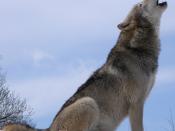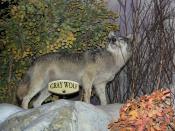Wolf Management in Wisconsin
Plans for today and the future
The gray wolf returned to Wisconsin in the mid-1970s and was listed as a state endangered species in 1975. A state recovery plan, initiated in 1989, set a goal for reclassifying the wolf from state endangered to threaten once the population remained at 80 or more wolves for 3 consecutive years. By 1999, the population had increased to 197 wolves, and had been at 80 or more since 1995. Therefore the Wisconsin DNR, has reclassified wolves from endangered to threatened, and developed this plan to manage wolves as a threatened and eventually as a de-listed species. Efforts have also begun to federally reclassify or de-list the gray wolf by the U.S. Fish & Wildlife Service (Wisconsin Wolf Advisory).
This plan will de-list the wolf from state threatened to a non-listed, non-game species when the wolf population reaches 250 animals based on late winter count across the state in areas outside Indian reservations.
A management goal of 350 is recommended.
Fourteen strategies were developed for managing wolves. These include:
1.managing wolves in 4 different management zones;
2.intensely monitoring wolf populations through threatened status and de-listed status;
3.monitoring wolf health;
4.cooperatively managing wolf habitat;
5.controlling nuisance wolves and reimbursing landowners for losses caused by wolves;
6.promoting public education about wolves;
7.establishing regulations for adequate legal protection of threatened and non-listed encouraging interagency cooperation;
8.establishing a system for program guidance;
9.encouraging programs for volunteer assistance on wolf conservation;
10.recommending future research needs;
11.regulating wolf-dog hybrids and captive wolves;
12.establish a protocol for handling wolf specimens;
13.Encourage reasonable ecotourism of wolves and their habitats. (WDNR).
Wolf population and health monitoring would remain intense for the future and will include radio telemetry tracking, wolf howl surveys, and track surveys. Management activities for Wisconsin's...


